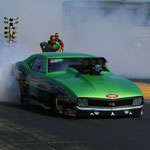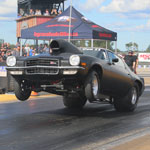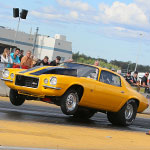The goal is to ensure that all Full Throttle Drag Show (FTDS)participants better understand the management of these events, from issues related to safety and security to the overall holding of this series. All competitors, team members and officials participating in FTDS events commit to maintain the regulations described bellow as well as showing great sportsmanship and ethical conduct throughout the series. In order to effectively understand these it is important they be read in full.
The following competition classes of vehicles are part of these events. A broad description would go like this : Super Pro (comprising all type and style of All Out Race Cars, for example, cars with or without doors, Dragsters, Altereds, etc., Semi Pro (full bodied cars without electronics assists), Modified Sleds and Junior Dragsters. Street Run + (Prestige de Rue) is an Invitational class also included to the programs, as are motorcycles types vehicles. Based on the particularities of each event on the calendar, additional competition classes, such as UDRAs Pro-Mods and Pro Heads-Up,will be added to the schedule. Further details pertaining to the description of competing classes is to be found bellow.
It should be noted that these regulations are inspired by those developed and applied by the National Hot Rod Association (NHRA). For example, these will be used in situation that require further problem solving resources, difficult situations, etc. In all cases the final decision will be adopted by the management of FTDS, including those resultant to the interpretation of rules and regulations, staging of the competition, handling of prizes, weather related, etc.
With regards to the condition and operation of all vehicles in competition, the responsibility rest principally with its owner and pilot. The main preoccupation of the FTDS is to ensure that the race conditions are as best as can be and safest for all. It considers it important to ensure that families, friends and other parties have a great place to be entertained. It believes that responsibility for positive progress in the promotion of drag racing motorsports is shared by all involved, or associated with this sport. Adherence to the standards reflected within is fundamental to achieving this success/goal.
For its part, the management ensures that the best available race conditions, systems and equipment is in place. This includes race management personnel, ambulance and fire department personnel, Jaws of Life and other specialized equipment such as track dryers, cleaners and surface preparation (Tire Rotators) and track sprayer are in place. This to ensure that the race environment is held at the highest standards it can adhere to.
Throughout the season, the FTDS will prepare and distribute a number of press releases and hold occasional press briefings. The objective is to regularly communicate and promote the events on its calendar, drag racing motorsport, family and related business activities. Your involvement and support within the framework of FTDS events is at the heart of this new motorsport banner.
Registration
Upon arrival at the ICAR complex, everyone must pay its entree fee. At the same time, competitors will register their entree in the competition class of their choice. Once the fees paid, a registration card will be issued. A competitor can purchase more than one card (ref. double entree, two cars).
Cards in hand, every competing pilot, car, and safety gear, must be brought at the inspection station area. This area is located near the head of the staging lanes. Based on issues preventing the completion of the inspection procedure, the competitor must see to resolve them. Upon being satisfied with the inspection, the competing vehicle will then be fitted with a sticker, designating it and its driver 'good-to-go' for the season.
A FTDS race membership card is offered to all competitors. The card holders benefit from discounts on the purchase of products offered by the series sponsors. Additional details are available of the FTDS web site.
Running of the events
Once the Staging Lanes are officially opened, only authorized vehicles are allowed in the Staging Lanes. The daily schedule of events will be posted ahead of the event. Under normal circumstances, qualifying sessions will begin at 9:00am.
Usually every program includes a minimum of three sessions of qualifications for every class. If the conditions arise, the race director can modify the schedule in an appropriate way.
Following the burn outs and staging models described by the NHRA, these must always be performed in a safe manner. This means that it is strictly prohibited to have someone in contact with the outside of the vehicle while doing its burnout. Matter of courtesy: If your burnout procedure differs from most, we encourage you to discuss this with the competitor you are paired with prior to heading into the warm-up area. Track officials in place at the water box will ensure that conditions are optimal at all times.
Once their runs completed and temporarily settled in the pits, we ask that all competitors wait to be called back to the staging lanes before heading back. Normally a period of 20 minutes is given between on-track rounds.
As a reminder to all teams and competitors, burnouts and other behaviour judged excessive are not allowed in the pits. We promote racing activities that are exercised in an environment and manner that is safe to all, as those described by the NHRA or pertaining Public Authorities. Any behaviour that is deemed dangerous by FTDS is considered matter for ejection from the facility.
Dial-Ins must be posted legibly on the vehicle, while making sure they can be easily read by the staff in the control tower. The usage of actual Dial-In boards (mechanical or electronic) is strongly recommended by FTDS.
While on the track,actions such as hard finish line braking, usage of real-time mechanical activating electronics, etc. are all matter for immediate expulsion from the race. In the event where cheating is suspected, an inspection can be asked for by a competitor, or by the management: The procedure will be following that outlined by the NHRA (1.6.5). Those found guilty of such illegal actions will lose all cumulated points and prize monies won to date. The extent of the disciplinary action is based on the severity of the infraction: Further actions can be placed on the guilty competitor.
The following is applicable to all motorized vehicles within the ICAR complex. Person behind the steering wheel must be at least 16 years of age and hold a valid diver's licence. The only exception to this rule is for young competitors handling their Junior Dragster entry. Those breaching this rule could be expelled from the premises. It is understood that adults are held responsible of the actions of those under aged guilty of breaching this rule: Both could then be expelled.
Once drawn up, copies of the ladders will be handed to the staff and pertinent announcements will be made using DragRaceQuebec.com for live feed and the track's PA system. Competitors must familiarize themselves with the details of the round pairings as they are updated. If a competitor cannot make it to the next round of elimination, whatever the reason, we would appreciate that track officials be informed a.s.a.p. so as not to uselessly slow the program down.
Races
Timing equipment used by FTDS is made by Port-A-Tree. This system is using electronic sensors that are capable of detecting the slightest of physical movements:Be forewarned. The Auto-Start function, controlling the amount of time the competing vehicles have to position themselves on the starting line, is enabled. If a competitor takes longer that the allocated time to stage his car, he will not receive a start signal, on his side of the tree. Details as to these system's delays will be made public on site.
Every competitor needs to place the front wheel of the race car at the starting line in such a manner that it will break the first light beam (Pre-Staged), then roll forward, and not back-in, to break the second one (Staged). Both top lights of the Christmas Tree will then be lid, all within the timed delays as stated above. Note that the race car cannot be pushed into position, that it has to be able to do so without any outside assistance; doing otherwise will lead to automatic disqualification. If a competitor wishes to use the Deep Stage method, he must inform the staff in the control tower prior to moving on the track.
During qualifying, the call to the designated lanes is made by the official at the head of the Staging Lanes. During elimination rounds, matched competitors must decide lane choice amongst themselves before they enter the burn out area: If both pilots want the same lane, we strongly recommend using the heads or tail method to resolve that standoff.
The Elimination ladders are prepared by the staff in the control tower. It is used as of the first round of elimination. Pairing ladders are drawn up using the same type used by the NHRA. With at least two representatives of the drivers contingent, the pairings are drawn from the registration cards. Buy back entries run together, not merged with the main group, until the round following the last opportunity to buy back. Those that have already benefitted from Busy Backs cannot receive a Bye-run during elimination, unless every other remaining competitor from the main group has already had one. If there are any changes to this way of proceeding, a public announcement will be made by the control tower staff.
Classes
Super Pro: 4:00 - and slower
All out racing chassis, all models.
Non-race approved ethylene glycol based cooling liquids (the likesof Prestone, Peak, and others) are not allowed.
Throttle Controls and Delay boxes permitted. Any other electronic devices, clocks, live data transmitting/receiving devices, or any other tools that can be used to control the vehicle, help the driver in locating the vehicle on the race track, etc, are not permitted.
Engine diapers are mandatory.
Semi Pro (Pro): 5:50 - 11:00
Modified production series vehicles with moderate modifications accepted, Power plants and chassis mods permitted. Street tires ans slicks (DOT or Race) permitted.
No electronics allowed in this class: exception for those managing N2O systems.
Non-race approved ethylene glycol based cooling liquids (the likes of Prestone, Peak, and others) are not allowed. No trans-brakes allowed.
Then use of engine diapers is highly recommended.
Street Run +: 7:00 and slower
Production cars, non modified: No aftermarket roll bar, or roll cages, stock wheel wells. Only modifications permitted are to powertrain and drivetrain.
Smooth thread track tire or DOT approved slicks allowed.
Various
Competitors not respecting rules and regulations pertaining to matters of safety can receive a 'no-go' signal on the track. The use of helmets is mandatory in all classes: it must carry a recognized accreditation, for example, by SNELL or a DOT equivalent. While safety clothing is mandatory for certain classes, it is highly recommended for all competitors. Safety standards are found in the NHRA rule book. Sanctions against those not complying with these rules could be applied.
Every vehicle entered in competition has shown to meet a certain level of safety standard. For example, new competitors must ensure that vehicles have good braking systems, that adequate driver safety harness in place and used. Those that are considered to be all-out race cars should already satisfy a higher standards as described by the NHRA, for example, the Super pro contingent.
Any competitor/driver consuming alcoholic beverages or using illegal drugs during the course of a racing event will not be tolerated: disciplinary action could include refusal at future FTDS events. It goes without saying that under such circumstances, reimbursements of paid fees are lost.
All considerations for reimbursements are to be assessed on a case-by case manner and decisions made at the discretion of the management of FTDS. This could include instances following medical situations, personnel family emergencies, etc..
For what might be obvious safety reasons, the FTDS will identify all competing vehicles burning methanol. Since methanol flames are not visible, a discreet, yet visible decal will be placed on these vehicles.
In Closing
The management of Full Throttle Drag Show wishes the best of luck to all competitors, spectators and friends of the Series, throughout the 2018 season. You are welcomed to communicate with us, to explore opportunities, or express suggestions that would further lead to improve our prized motorsport competition environment.
|




